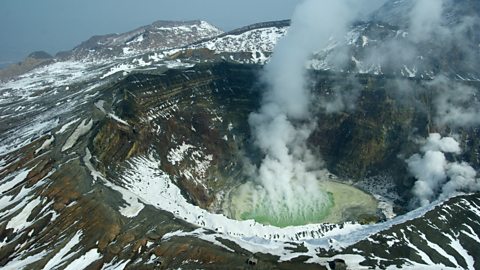Volcano locations
Volcanoes form when magmaMolten rock that is found within the Earth., molten rock from the mantle, reaches the Earth's surface. The magma erupts to form lavaMolten rock that is released from the Earth's core in a volcano or fissure. at the surface, either on land or under the sea.
Volcanoes usually form along plate marginThe region where two or more tectonic plates meet. It is a zone of intense seismic activity., where crustal plates are either moving towards or away from one another.
- constructive plate marginAn area where two tectonic plates are moving away from one another. - this is where two plates move away from one another. Magma rises to fill the gap between.
- destructive plate marginWhen two tectonic plates move towards one another. The oceanic crust is forced to sink back into the mantle, whilst the continental crust rises above. Volcanoes and earthquakes are found here. - this is where two plates move towards one another. Heavy oceanic crust sinks beneath the continental crust at a subductionWhen one crustal plate is forced beneath the other. zone - a point where one crustal plate is forced beneath another. As the oceanic crust sinks into the mantle, it melts into magma, which rises to the Earth's surface to form an explosive volcano.
Volcanoes can also form over hotspotA hotspot occurs when there is intense heat in the mantle which rises towards the crust. When the melted rock (magma) reaches the surface it creates volcanoes, eg the Hawaiian islands..

The impacts of volcanoes can be more severe in low income developing country (LIDC)Any country that is among the poorest in the world, based on per capita income., where there are fewer resources to predict and prepare for them.